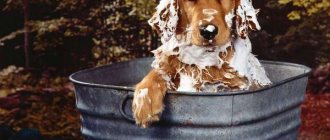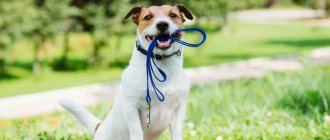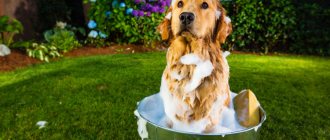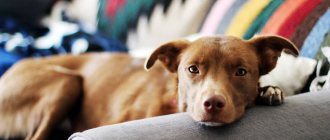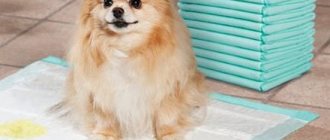Risk of infection and general health
Think about all the surfaces your dog puts his paws on. Now imagine what bacteria and microbes can get into cracks in the skin. The dog's body can cope with bacteria, but only within reasonable limits.
How can you tell if your dog's paws are okay? Just smell them. If you smell the aroma of corn, chips, potatoes, bacteria are already attacking the body, and the fungus is waiting for the right moment to start spreading over the skin.
Note! If you wash your dog's paws regularly, any injuries will be detected in time.
Some dogs develop interdigital cysts, which can become painful. Ticks like to hide between the toes and “suck” behind the pads of the paws. The skin of the paw pads can be injured on the asphalt, the dog can get burns or frostbite, the claws break and crack... these are just some of the possible problems, the treatment of which should be as prompt as possible.
When to wash your dog's paws
Everyone understands that a dog should be taught to wash its paws from puppyhood, but somehow they are lazy. Wet weather is an excellent reason to start training. Believe me, your pet is also not happy about the lumps of dirt that stick to his fingers and fur.
What happens if you don't wash your dog's paws in rainy weather? In addition to dirt in the house, over time, the skin on the pads will become looser and more vulnerable to injury. When the skin is constantly in a humid environment, its sensitivity increases, and this negatively affects the well-being and behavior of the pet. It follows from this that the dog’s paws must not only be thoroughly washed, but also dried after going outside.
High air temperature
Most dog owners believe that if it is warm and dry outside, then the dog cannot have dirty paws. In fact, this is not the case; dust mixes with sebum and sweat (dogs only sweat through their paw pads) and forms dirt.
In summer, in hot weather, another threat arises - burns. This problem occurs especially often if the dog has to walk on asphalt surfaces. Washing paws in the summer helps the skin recover faster, which minimizes the damage of walking on hot ground and asphalt.
Snow and cold
Your feet were probably freezing, despite socks and warm shoes, your fingers were so numb that you lost sensitivity. Now imagine that you need to walk in the snow wearing only socks, without shoes.
When not to wash your pet
You can't bathe your dog:
- within two weeks after any operations, including castration (you must wait until all postoperative sutures on the skin have completely healed),
- within 7-10 days after vaccination (risks of colds and infection of the injection site),
- when the dog is sick and within a week after recovery, regardless of the type of illness,
- if there are visible skin lesions on the body (deep wounds, abrasions, signs of infectious inflammation),
- during pregnancy, if this process causes negative emotions in the animal,
- during the treatment of lichen.
If you can’t bathe, and the dog, for example, is smeared somewhere in the mud, it is enough to remove heavy dirt with a wet sponge/rag, and then use “dry” shampoos (powder). They are sprinkled over the animal's body, and then the fur is carefully combed out with special brushes.
Before any bathing, be sure to cut off areas with tangles (matted fur) on the dog - it is not recommended to bathe with them, because... a stagnant, humid environment inside them will contribute to the development of various infections and parasites.
How to properly wash your dog's paws
It would seem that the answer to this question is obvious, but every third dog owner cannot correctly name all the “steps” correctly.
- Do not wash your paws right away. Secure the leash and wait 3-5 minutes.
- If your dog is very cold, dry his paws with a towel before washing.
- Never wash your paws with cold or hot water; the temperature should be at room temperature.
- Inspect the paws while washing; all injuries and cracks should be treated immediately.
Soap and water
The most common and effective option is a bucket of water and mild soap. Soap should be added to water and stirred.
We dip the paw in water, rinse it, and wipe it. This option is not convenient for everyone, since the dog puts wet paws on the floor, water spreads, and this can have a detrimental effect on the floor covering.
Paper or absorbent towels
This option has a lot of advantages:
- No need to wait.
- No wet marks are left.
- You can wipe your paws without entering the house.
There is only one minus - the financial side of the issue.
Paper towels can be used both during the rainy season and in the summer. By the way, in the summer, it is enough to wipe your paws with a regular cotton towel. If you want to keep your home clean, you should moisten the towel with a spray bottle and wash it every day.
Wet wipes
Wet wipes are convenient because they can be used at any time of the year. It is important to pay attention to impregnation! Choose unscented baby wipes. Often, scented wet wipes are soaked in cheap, diluted liquid soap, which is bad for skin health.
Rules for washing limbs
Many owners wash their four-legged pets' paws only after a walk in rainy weather. This approach to hygiene is wrong. Dogs' limbs get dirty during every walk, even if visually there are no obvious signs of contamination. In addition, on the street the animal faces many dangers, namely:
- injury to pads from broken glass;
- contact with gasoline or fuel oil on the skin surface;
- formation of splinters;
- harmful effects of reagents used to combat snow.
First aid for cut paws
These factors contribute to the development of inflammatory processes in the paw pads, the occurrence of dermatitis and allergic reactions. To prevent the formation of such pathologies, it is necessary to treat the pet’s limbs at the end of each walk.
Wounds on the paws are one of the possible consequences of walking around the city
General washing tips:
- Before each procedure, the pads should be inspected for cracks, wounds, or foreign objects. Since paw injuries are not always accompanied by lameness, visual inspection should be carried out scrupulously. If an animal with a damaged limb has been playing outside for a long time, being in a state of emotional arousal, it may not respond to skin damage.
- After a walk in dry weather, you can limit yourself to wiping your paws with a damp cloth.
- If there is slush outside, limbs must be washed with water and detergent.
- You can carry out such a manipulation in the bathroom or use a basin of water left in advance at the doorstep of the apartment. The choice of method depends on the size of the pet
- At the end of the procedure, you need to wipe your pet's paws with a cloth.
As an alternative to dog shampoos, you can use tar soap.
By following these simple instructions, you can protect your animal from the development of many diseases and keep your home clean.
When wiping extremities, it is preferable to use microfiber-based cloths
How to properly wash your dog's paws after a walk
You should definitely wash your dog’s paws after going outside, even if you don’t consider yourself a clean person. This procedure is needed not only to maintain order in the house. In winter, paws are exposed to reagents that are sprinkled on ice, and in the warm season, the dog can step into gasoline, motor oil, or chemicals of unknown origin.
If you do not wash your paws from caustic substances in time, this can lead to burns or skin irritation. In addition, the animal can lick its paws and become poisoned. You should wash your paws more thoroughly than usual after visiting the veterinary clinic. On their paws, pets bring pathogenic bacteria and worm eggs into the house. Without paying due attention to paw hygiene, you risk harming the health of not only your pet, but also family members, as well as other pets, if you have them.
Let's figure out what and how to wash your dog's paws to avoid trouble, as well as make washing quick and comfortable.
How can you wash your dog's paws?
To wash your dog's paws, you can purchase a soft brush at a hardware store.
You need to rinse your paws with warm, but not hot water. Cold water will not be able to remove all contaminants, and it is also unpleasant for the dog. An alternative option is to wipe the extremities with damp wipes containing antibacterial impregnation.
It is better to wash very dirty paws with shampoo. It dissolves fat, stubborn dirt, removes unpleasant odors and does not irritate the skin. If you don’t have shampoo, a mild soap without a strong fragrance will do. Many breeders often wonder whether it is possible to wash a dog’s paws with laundry soap. You should not do this, as this soap degreases the animal’s skin too much.
If gasoline gets on the fur, remove it with car detergent.
After visiting a veterinary clinic or other places with a large concentration of animals, paws should be treated with a disinfectant spray.
What you might need to wash your paws
To keep your pet's paws clean and healthy, it is advisable to purchase the following things:
- Basin with water . It is placed either near the front door or in the bathroom. If you are washing your dog in the bathtub and are concerned about clogging the drain with dirt and debris, you can place a basin or baby bath directly in the bathtub. After washing, flush the water into the toilet.
- Anti-slip bath mat . It is especially important when the dog is accustomed to jumping out of the bath on its own after washing - at this moment it is easy to slip and get bruised.
- Dog shampoo or paw soap. Buy these products only in specialized stores and do not use human ones. Shampoo or special soap can be diluted in water, or you can apply it to a sponge and wipe the dog’s paws with this sponge. Don't get too carried away with detergents. Use them on heavily soiled areas rather than on an ongoing basis as they can dry out the skin.
- A cotton towel , or better yet two. One is to put a wet dog on it, and the second is to wipe it off.
- Microfiber cloths . They are good for removing small dirt. They absorb water well, dry quickly, and do not leave lint.
- Wet wipes – these can be used after a walk in dry weather.
- Tar soap is useful if there are wounds or abrasions on the paws. It relieves inflammation and disinfects, and also accelerates the skin restoration process.
- Tweezers - in case there is debris (pebbles, pieces of glass, etc.) clogged between the fingers or under the claws.
- Autogel for hand washing . Gasoline and other automotive fluids cannot always be washed with soap, so it doesn’t hurt to purchase a special gel just in case. It removes fuel oil, oils, grease, and rust. It is unknown how a dog's skin will react to it, so only use this product when all else fails.
Do I need to bathe at all?
- Pet for the yard. If the dog constantly lives in outdoor conditions - in the yard, in an enclosure, on a leash near a booth, then there is no urgent need to bathe the animal. Those. The dog may not bathe at all throughout its life. Exceptions - the animal is smeared in dirt, something strong-smelling or chemical.
- Home pet. Bathing an apartment pet is a matter of pet hygiene and safety.
- Hygiene. In some dogs, the secretion produced by the skin for the coat has a foul smell (this can be clearly heard especially when the coat gets wet). A persistent unpleasant odor appears, colloquially referred to as the “smell of dog.” The frequency of bathing in this case is determined by the owners themselves, so that the dog’s stay is comfortable for all family members. Also, many four-legged friends sleep with their owners, climb onto sofas and armchairs, i.e. The question of “to wash or not to wash” should not even arise - the animal should always be clean.
- If the animal is dirty or has fallen in something, bathing is out of schedule and plans. If the dog does not smell bad, then it is enough to limit yourself to 1-2 bathing procedures per year, provided that the paws are washed daily after each walk.
- Safety. After a walk (especially in winter), you should definitely wash your dog’s paws. Dust is the most harmless thing that can get dirty in dry weather. In winter, these are chemical reagents that pose a danger to paws, all kinds of scattered poisons spreading in puddles (you can get poisoned by licking unwashed wet paws). You need to make it a rule to wipe your paws with a wet cloth after a walk in dry weather and wash them well after rain and snow in winter, even if you have to do this every day and several times a day. Also, an emergency bath should be arranged immediately if the dog has turned over something toxic and chemical on itself (for example, it has been sprinkled with washing powder or doused with a chemical household liquid).
- Healing procedures. Sometimes the animal has to be bathed in order to get rid of cutaneous or intradermal parasites. It doesn’t matter here whether it’s a pet or a yard animal – treatment in the form of washing needs to be done.
- Summer swimming. In the heat of summer, you can simply spray your dog with water (without shampoo) to prevent overheating. But very often an unpleasant odor appears from wet wool, so in such cases you will still have to use detergents.
Washing paws after a walk
Now let's move on to the washing procedure itself. In dry weather, you can do without it - just wipe your paws with a damp cloth or napkin .
When the street is dirty, you can place a basin of water at the entrance to the apartment. First, wash your pet's front paws in a basin, then place them on a towel and dry them, then wash the back paws. Wipe your stomach with a rag. If the dog is not yet accustomed to this procedure and tries to run away, you can attach the leash to the handle of the front door.
During periods when spring and autumn slush reigns in the yard, not only a rag, but also a basin of water will be powerless. You can't do this without a bath. Check the temperature of the water you use to wash your dog's paws - it should be a little cooler than for washing human hands.
If the dog is small, the easiest way is to carry it into the bathroom in your arms, put it in the sink and wash each paw in turn. To prevent a large dog from getting the floor dirty on the way to the bathroom, you will have to cover it with something.
When you have finished washing, inspect the paw pads and the space between the toes. Is everything clean, everything okay? Now you can wipe your paws dry and let your pet go in peace.
Rules for washing paws for large dogs
It is easiest to clean the limbs of small animals. You can easily carry them in your hands to the bathroom and wash them. With representatives of large breeds the situation is more complicated.
Rules for removing dirt from paws:
- Before walking, place a container of warm water and a rag near the front door. It is advisable to use fabric that absorbs moisture well.
- Pre-spread a waterproof mat for water procedures.
- Depending on the volume of the pelvis and the size of the pet, one limb or 4 at the same time are dipped into the water.
- After washing, dry your paws with a rag or towel.
- If your pet is not a fan of water treatments, experienced dog lovers recommend using a paw wash. With this device you can avoid splashing water around the room. However, this device does not always cope with heavily soiled paws.
A paw wash is a great helper for cleaning limbs.
In a private home, it is advisable to install a special design for washing paws, making it easier for the owner to carry out hygiene procedures.
Shoes for dogs will help reduce the degree of contamination of the limbs. Special galoshes will protect the animal from the harmful effects of reagents, fuel oil, glass and snow. However, not all pets react enthusiastically to such an innovation. In addition, some models harden from frost.
Mini-bathroom for washing four-legged friends
Recently, waterproof rubber socks have appeared on the market. They are considered a more comfortable alternative to dog shoes because they allow your pet to feel contact with the ground. In such sensitive clothing, the dog loses the desire to pull off its protective socks.
Shoes for dogs - a stylish accessory to protect against paw injury
How to train a dog to wash its paws after a walk
All your good intentions to maintain cleanliness will come to nothing if the dog resists washing. Some pets even refuse to go home because they don’t want to wash themselves!
You need to start teaching your dog good hygiene as early as possible. This is stressful for the animal, although most dogs are not afraid of water and have a positive attitude towards bathing. You should not immediately drag the puppy into the bathtub and pour water on it - teach him to wash gradually and patiently.
Hold your puppy's paws often so that he gets used to being touched and won't resist being washed in the future. After some time, connect napkins or a towel - wipe the puppy’s paws one by one and treat him with a treat. A clear “wash-treat” connection should be fixed in his head. When this happens, you can move on to a larger scale wash. Many dogs enthusiastically run to wash themselves and jump on the towel to get a reward.
How to wash your paws correctly
Typically, owners use a basin to wash the paws of dogs of medium and large breeds. To prevent your pet from getting nervous and getting used to this procedure, you should follow a few simple rules:
- Before washing, you should carefully inspect the pads for wounds or foreign bodies.
- Place a basin and a rag near the front door, lay down a rubber mat, and place a dry towel next to it.
- Check the water temperature. It should be cool in winter, warm in summer.
- Use a washing sponge, which saves shampoo.
- First, wash the front paws, wipe the dirty belly, and then proceed to the hind paws. If your dog is washing himself in the bathroom, you need to immerse his paws in the water one at a time.
- The best way to dry your paws is with a microfiber towel.
Some dogs can wear outdoor booties or slippers. This will be the best preventive measure, and you won’t have to torture your dog every time by washing his limbs.
The pet must learn to wash its paws from puppyhood. In order for him to get used to this process, you will need to be patient. You can teach your dog to be touched by rubbing his paws with a dry towel and rewarding him with treats.
Why and how to wash your dog's paws
Why does a dog need to wash its paws after every walk, even if it’s dry and warm outside? What means can be used for these purposes? How to carry out a hygiene procedure. What to do if your pet does not want to wash its paws. How a paw wash makes things easier for the owner.
A dog living in a house or apartment should wash its paws after every walk. This is not a whim of neat people, but a necessity, although most owners prefer to do this only during the period when there is dirt or slush on the street.
Why wash your pet's paws?
First of all, paws are washed not because of visible dirt, but because of bacteria. They accumulate on the pads, and after a walk they quickly spread throughout the house. A simple cut, crack or wound is a pathway for accumulated bacteria to enter the body and cause illness. Therefore, it is not the cleanliness of the apartment that forces you to wash, although it is also important.
Dirty paws ruin expensive rugs and furniture. It is unlikely that washing paws is more difficult than cleaning an entire room after a pet has run through the puddles in the yard. In addition, carpeting cannot always be washed perfectly.
The dog just returned from a walk? This means that in addition to washing, the owner must check the condition of the pads for the presence or absence of inflammation and cuts. In warm weather, ticks and other parasites can be found between the fingers. If left untreated, this is also bad for health.
Should you wash your dog's paws after every walk?
How often should you wash your paws? Unlike bathing, which is done at least once every three months, there is no specific advice on when to clean paws. However, if the dog lives indoors, the owners clean its paws daily after a walk. Their contamination depends on the pet's activity level and the season. For example, hot summers and slushy winters are factors that make you wash your paws more often. A dog that spends most of its time outside and just wandering around the neighborhood may only need brushing every 1-2 weeks.
Important! You don't need a microscope to find out if there are bacteria on your paws. Just smell them. If there is an odor, then there is bacteria.
Why does a dog need to wash its paws?
- Because of the banal dirt on the street that appears after rain or snow thawing.
2) Along with dust and dirt, at any time of the year, an animal can bring infections and helminth eggs on its pads, which are successfully spread throughout the home.
3) A pet can quietly run through a puddle of oil leaked from a car, a puddle of gasoline or other chemicals, and then bring it home.
4) In winter, sidewalks and roads are generously sprinkled with special substances so that they are not slippery, but they may well cause irritation and inflammation of the pads.
5) During an active pastime, a pet may step on a sharp fragment, nail or other object, after which a wound appears. You can notice it while washing. If the damage is not treated promptly, it may fester.
You can find a variety of products for washing limbs in the pet store: soap, shampoo, foam, gel. Some of them contain disinfecting substances, others accelerate the healing of injuries, relieve inflammation, and still others kill parasites - fleas, ticks, etc. However, you can protect your dog’s pads with shoes, then there is no need to wash them after every walk.
How to wash your dog's paws
- Fill the basin with water and check the temperature. It is important that it is warm and not hot, otherwise it will be difficult to persuade the dog to perform hygiene procedures in the future. But in winter, it is preferable to use cool water so that the pet does not suffer from sudden temperature changes.
2) Prepare a towel that absorbs water well.
3) Take a washcloth or regular dishwashing sponge, moisten it in a basin and apply detergent, foaming it well directly on the sponge.
4) Place the dog’s forelimbs in the basin, wipe them thoroughly with a soapy sponge, and at the same time inspect them for wounds, splinters, and ticks.
5) Then place your hind paws on the prepared towel.
6) Wash the hind legs in the same way and dry with a towel.
A pet should be accustomed to hygiene procedures from the first months of life, since in adulthood it will resist. If the dog has difficulty agreeing to wash its paws, then it is advisable to motivate it by giving a treat each time after the procedure is completed. Over time, the animal will get used to it and will happily begin to feed its smeared paws.
Pet stores sell special devices to make the task easier for the owner - paw washers. It is enough to insert each paw one by one inside the paw washer, where the dirt is removed with the help of brushes. The owner can only add detergent, and then inspect and dry the animal’s limbs.
Here is a video showing the paw washer and the paw washing process:
